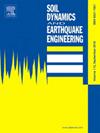Comparative study of undrained cyclic behavior of calcareous and siliceous sands under multidirectional simple shear loading
IF 4.2
2区 工程技术
Q1 ENGINEERING, GEOLOGICAL
引用次数: 0
Abstract
Calcareous sands provide the foundational support for various marine infrastructures. In the harsh marine environment, earthquake or wave loads apply multidirectional cyclic shear stresses to the foundation soil. To explore the undrained multidirectional cyclic response of sand, a series of simple shear tests were performed on reconstituted sand specimens considering the effect of phase difference (θ). By comparing the results with those of siliceous sand under similar conditions, the behavior of calcareous sand under multidirectional cyclic loading became clear. The results demonstrated that calcareous sand shows a lower degree of cyclic instability compared to siliceous sand, corresponding to the weaker strain-softening observed in calcareous sand during monotonic shear tests. The trend in normalized pore water pressure evolution in siliceous sand exceeds that in calcareous sand. Furthermore, under multidirectional cyclic shear conditions, the liquefaction resistance decreases by 30 % in extreme cases, irrespective of sand type. The liquefaction resistance of calcareous sand surpasses that of siliceous sand. However, as the cyclic stress ratio decreases, the reverse trend is observed, regardless of the impact of θ. Subsequently, the possible causes of the above experimental phenomena are explored from the perspectives of shear modulus and energy dissipation.
求助全文
约1分钟内获得全文
求助全文
来源期刊

Soil Dynamics and Earthquake Engineering
工程技术-地球科学综合
CiteScore
7.50
自引率
15.00%
发文量
446
审稿时长
8 months
期刊介绍:
The journal aims to encourage and enhance the role of mechanics and other disciplines as they relate to earthquake engineering by providing opportunities for the publication of the work of applied mathematicians, engineers and other applied scientists involved in solving problems closely related to the field of earthquake engineering and geotechnical earthquake engineering.
Emphasis is placed on new concepts and techniques, but case histories will also be published if they enhance the presentation and understanding of new technical concepts.
 求助内容:
求助内容: 应助结果提醒方式:
应助结果提醒方式:


